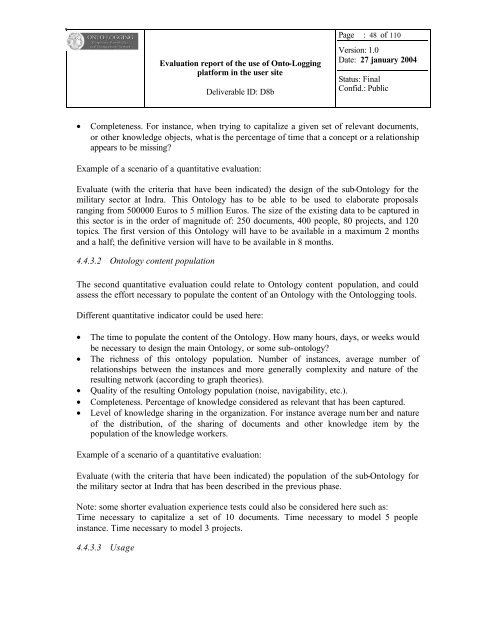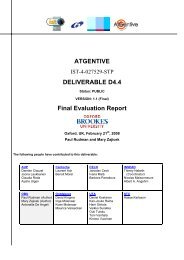pdf 820Kb - INSEAD CALT
pdf 820Kb - INSEAD CALT
pdf 820Kb - INSEAD CALT
Create successful ePaper yourself
Turn your PDF publications into a flip-book with our unique Google optimized e-Paper software.
Evaluation report of the use of Onto-Logging<br />
platform in the user site<br />
Deliverable ID: D8b<br />
Page : 48 of 110<br />
Version: 1.0<br />
Date: 27 january 2004<br />
Status: Final<br />
Confid.: Public<br />
• Completeness. For instance, when trying to capitalize a given set of relevant documents,<br />
or other knowledge objects, what is the percentage of time that a concept or a relationship<br />
appears to be missing?<br />
Example of a scenario of a quantitative evaluation:<br />
Evaluate (with the criteria that have been indicated) the design of the sub-Ontology for the<br />
military sector at Indra. This Ontology has to be able to be used to elaborate proposals<br />
ranging from 500000 Euros to 5 million Euros. The size of the existing data to be captured in<br />
this sector is in the order of magnitude of: 250 documents, 400 people, 80 projects, and 120<br />
topics. The first version of this Ontology will have to be available in a maximum 2 months<br />
and a half; the definitive version will have to be available in 8 months.<br />
4.4.3.2 Ontology content population<br />
The second quantitative evaluation could relate to Ontology content population, and could<br />
assess the effort necessary to populate the content of an Ontology with the Ontologging tools.<br />
Different quantitative indicator could be used here:<br />
• The time to populate the content of the Ontology. How many hours, days, or weeks would<br />
be necessary to design the main Ontology, or some sub-ontology?<br />
• The richness of this ontology population. Number of instances, average number of<br />
relationships between the instances and more generally complexity and nature of the<br />
resulting network (according to graph theories).<br />
• Quality of the resulting Ontology population (noise, navigability, etc.).<br />
• Completeness. Percentage of knowledge considered as relevant that has been captured.<br />
• Level of knowledge sharing in the organization. For instance average num ber and nature<br />
of the distribution, of the sharing of documents and other knowledge item by the<br />
population of the knowledge workers.<br />
Example of a scenario of a quantitative evaluation:<br />
Evaluate (with the criteria that have been indicated) the population of the sub-Ontology for<br />
the military sector at Indra that has been described in the previous phase.<br />
Note: some shorter evaluation experience tests could also be considered here such as:<br />
Time necessary to capitalize a set of 10 documents. Time necessary to model 5 people<br />
instance. Time necessary to model 3 projects.<br />
4.4.3.3 Usage
















